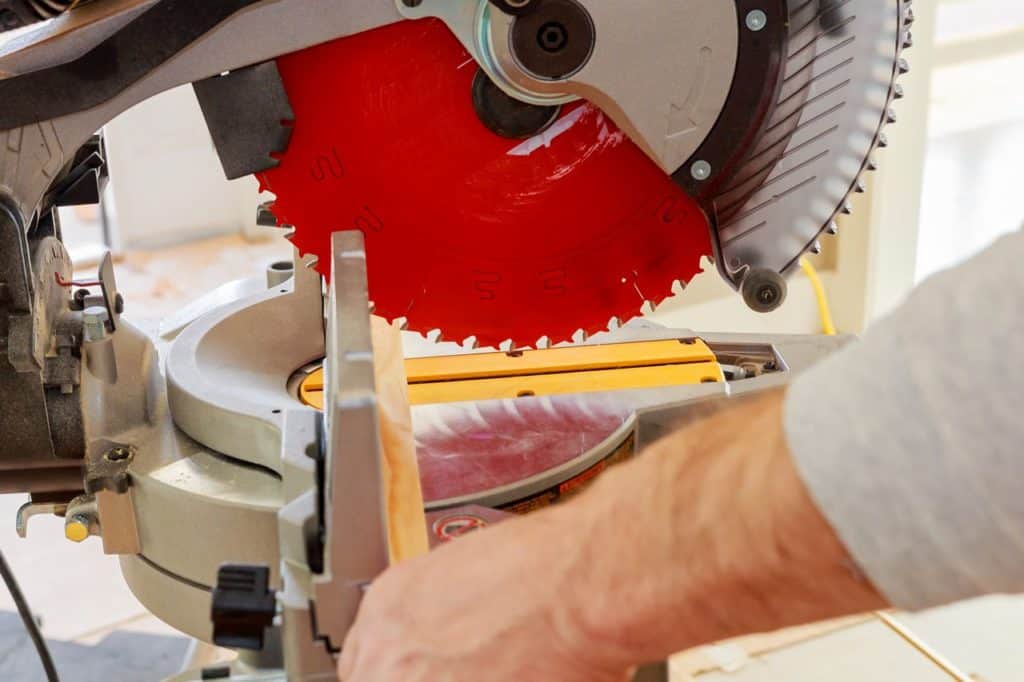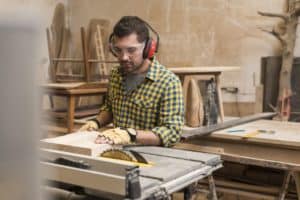
If you are busy with a home DIY project, work in construction or are just curious about materials you have probably wondered if you can saw particle board? Working with a new material does not have to be difficult and particle board is not so different from most other wood-based materials. So, the short answer is:
Yes, you can saw particle board. For cutting the board, you should use a powered saw while hand tools are not recommended for this material.
Read on to learn how to do it and which tools you could use.
How Particle Board is Made
Particle board is also known as low-density fiber board (LDF). It is a wood composite made by using recycled waste wood. Wood chips, shavings and sawdust are combined with a binding agent, such as resin. They are then pressed into sheets (source). Manufacturers may also add further chemicals to the mix before the pressing stage to make the boards water-resistant, bug-repellent or fireproof.
Because of this manufacturing process particle board is really strong, it is commonly used in construction for floor bases and walls. Also, furniture such as tables or shelves can be made from particle board. However, being made of wood chips and sawdust does mean that it is way more prone to splintering than a traditional wood board.
If that sounds scary, do not worry, it does not have to be at all. Just because particle board is a bit more likely to splinter than regular wood it does not mean it is not a great material that can be easily cut with the right tools.
Read more about particle board in this article where we also compare it with fiberboard.
Which Tools Are Best for Cutting Particle Board?
If you want to get the cleanest cut and produce the best quality product you can, you’re going to need the right tools. If you’re an avid woodworker or in the construction trade you probably already own one or more of the tools on this list.
Cutting Particle Board with A Table Saw
If you are really serious about getting a good finish on your cuts then a table saw is undoubtedly the best tool for the job.
The fixed blade of a table saw allows the highest level of precision and the high-power blades make light work of the particle board without causing splintering or jagged edges.
Learn more about table saws in this article.
Using a Track Saw
If you are working on really large pieces of particle board and do not have anyone to help then a table saw can be impractical. This is where the track saw comes in.
Track saws are precise, highly portable and able to be used by one person by themselves. There is plenty of power behind those blades too, to ensure that same smooth cut.
Sawing Particle Board with a Circular Saw
Handheld, agile and offering more than enough power for the job, the humble circular saw is incredibly versatile. It is no wonder that these saws are just as great for cutting particle board as they are for other DIY tasks.
Make sure you fit the right blade before cutting anything to avoid damaging your board. However, note that a circular saw as a hand-held tool is generally less precise than a table or a drop saw. Therefore, you might prefer one of those types if you wish to get perfectly straight cuts.
Using a Miter Saw for Particle Board Cuts
If you are working with smaller workpieces of LDF, a miter saw is probably the better choice than a circular saw. It offers much more precision while it is also portable. It is the perfect tool to cut certain angles which is useful for furniture-making, for instance.
However, the maximum size of the workpieces is somewhat limited due to the shape of the saw. But if that works for your project, it is a good tool to go for.
Read this guide to using miter saws where we explain in 4 steps how to get the perfect cut.
Cutting LDF with a Bandsaw
No good (semi)professional workshop is complete without a bandsaw. This is especially true if you want smooth clean cuts in your particle board. The high-speed blade cuts through boards like a hot knife through butter, while allowing for a high level of precision in the cut.
However, this type of saw is not too wide-spread among DIYers. So, if you do not have one yet, you can just use one of the other tools on this list.
Other Types of Saws
If required by the project, you can also use a jigsaw for the job. Scroll saws and reciprocating saws, on the other hand, are generally not recommended for LDF projects.
Read more about bandsaws and jigsaws here where we explain their characteristics and differences.
How to Cut Particle Board
In this section, we are going to share tips and tricks on how to saw LDF.
Is Cutting Particle Board Hard?
Cutting particle board is different from cutting wood. Compared to most types of wood, it also requires different skills and experience. With the right tools and some skill, most DIYers are able to saw LDF in typical projects around the house.
Particle board components that used in professional construction are a different story though. These require heavy-duty saws, several people and professional training in cutting such LDF boards.
What Is the Best Way to Cut Particle Board?
First of all, you need the right tools. A table saw, a track saw or a bandsaw are ideal. However, a circular and (for small chunks) a miter saw will do the job as well. Just do not use a hand saw or a chisel.
Once you have the right tools and blades, you can measure and mark where you are going to cut. You will need some protection and preparation of the work area and the equipment until you can make your first cut.
Read on for more details.
Measure and Mark
Now I know we’ve all heard it before, but measure twice, and mark your lines before cutting. You can always re-measure and re-mark, but it is not possible to un-cut a board.
If you are using a circular saw or another power saw without a fence or guide you can use masking tape as a guideline for where to cut. However, this may cause your edges to come out a little rougher than usual.
Prepare the Work Area and Protect Yourself
You need to protect your lungs when working with particle board. Fine dust from wood and resin composites are really bad for your health. Resin dust is especially hazardous to the lungs. Work in an area with proper ventilation and extraction. Wear a mask to prevent the inhalation of dust.
Get Your Equipment Ready
Use sharp well looked after blades and you’ll be rewarded for your efforts. Using dull blades to cut anything is going to frustrate you, potentially ruin your particle board and at worst can pose a serious safety hazard. Blunt blades slip and because of this are more likely to cut you than a sharp well-oiled one will.
Cutting the Particle Board
If you’re working with a particle board that has a veneer covering on one of the sides then make sure to cut the material veneer side facing up. Even the best tools leave a slightly rougher edge on the side of the board that faces down.
The binding resin or glue in particle board can eventually build up on your saw blade and make it dull. You can clean off this gunky mess by simply applying a lubricant and scrubbing it with a medium bristle brush, a toothbrush works great for this task.
Learn more in this video:
What You Should Avoid when Sawing LDF
Now that you have understood the structure of the board and how to cut it, we are going over some basics of what not to do when cutting particle board (source).
Can You Use a Chisel for Particle Board?
First of all, absolutely under no circumstances ever use a chisel on particle board. Chisels splinter and destroy the structure of the material due to the compressed wood chip manufacturing process. Even though these boards are made of wood it is important to remember that they are not the same as wood that comes directly from a tree.
Can You Cut Particle Board with a Hand Saw?
Hand saws are generally not a good idea to use when cutting particle board either. When you hand saw the boards, you will not be able to move your arm with enough speed and power to breeze through the material as a power saw does. What happens when you do not have enough speed and power? You get splintered boards and jagged edges.
If you really want a good finish on your end product you need to use the right tools for the job.
Conclusion
All in all, sawing particle board does require a little more care and attention than working with wood (the less demanding one) or other material might. However, given the right tools and knowledge, it does not have to be difficult at all.




